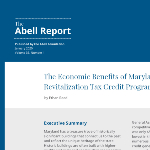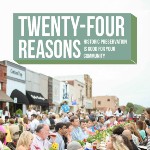The economic impact of historic preservation have been highlighted in two newly released reports.
THE ECONOMIC BENEFITS OF MARYLAND’S HISTORIC REVITALIZATION TAX CREDIT PROGRAM
THE ABELL FOUNDATION, 2020
 The Abell Foundation released its report, The Economic Benefits of Maryland’s Historic Revitalization Tax Credit Program, on which Preservation Maryland consulted. Based on its findings, which outlines the program’s history and impact, the report makes recommendations on how to strengthen this vital community revitalization tool, including:
The Abell Foundation released its report, The Economic Benefits of Maryland’s Historic Revitalization Tax Credit Program, on which Preservation Maryland consulted. Based on its findings, which outlines the program’s history and impact, the report makes recommendations on how to strengthen this vital community revitalization tool, including:
- Remove or increase program and project caps;
- Make the credit transferable;
- Provide Maryland Historical Trust adequate resources to maximum effectiveness and efficiency of the program and application/award process; and
- Support small commercial projects.
Preservation Maryland has been advocating for these recommendations for many years. This session of the Maryland General Assembly, we are championing legislation, sponsored by Senator Katie Fry Hester and Delegate Stephanie Smith, that will both increase funding and make the credit transferable.
TWENTY-FOUR REASONS HISTORIC PRESERVATION IS GOOD FOR YOUR COMMUNITY
PLACEECONMICS, 2020
 PlaceEconomics, a private sector firm that specializes in thorough and robust analysis of the economic impacts of historic preservation that is currently working on a study of the City of Baltimore’s historic tax credit, published “Twenty-Four Reasons Historic Preservation is Good for Your Community.” Using case studies in cities across the country, the report innumerate not only the economic benefits, of which there are many, but also the environmental impact of historic preservation. In fact, a Maryland study by economic analyst Joseph Cronyn and environmental economist Evans Paull receives a call out. In comparing the differences in the environmental impact of rehabilitating a 50,000 square foot historic industrial building to constructing a new building on the outskirts of the city, Cronyn and Paull found that historic preservation:
PlaceEconomics, a private sector firm that specializes in thorough and robust analysis of the economic impacts of historic preservation that is currently working on a study of the City of Baltimore’s historic tax credit, published “Twenty-Four Reasons Historic Preservation is Good for Your Community.” Using case studies in cities across the country, the report innumerate not only the economic benefits, of which there are many, but also the environmental impact of historic preservation. In fact, a Maryland study by economic analyst Joseph Cronyn and environmental economist Evans Paull receives a call out. In comparing the differences in the environmental impact of rehabilitating a 50,000 square foot historic industrial building to constructing a new building on the outskirts of the city, Cronyn and Paull found that historic preservation:
- Reduced Vehicle Miles Traveled (WMT) by 20%-40%;
- Reduced travel related CO2 by 92-123 metric tons;
- Had a retained embodied energy of 55,000 million BTUs;
- Preserved 5.2 acres of greenfield land;
- Reduced demolition debris going to the landfill by 2,500 tons;
- Saved a value of $100,000 in natural resources; and
- Had a savings of between $500,000 and $800,000 in infrastructure investment.
Looking at these numbers calls to mind the words of Carl Elefante, FAIA, FAPT, LEED AP, renowned leader in sustainablilty in architect, who famously stated, “The greenest building is the one already built.” To that point, Preservation Maryland is working on a number of bills during this Session of the Maryland General Assembly that promote smart growth and environmental issues.
Preservation Maryland is encouraged by the outcome of these reports, which reinforce the far-reaching revitalization benefits of historic preservation.
